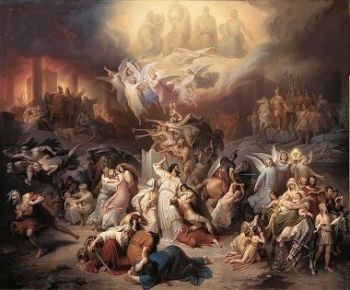
Psychologists tell us that there are different “ages” in the life of a human being. The “child age” gives way to the “adolescent age,” and the “adolescent age” disappears into the “adult age,” and “old age” turns into the “death age.”
Sociologists and historians tell us that institutions and societies also have “ages.” As much as we’d like our current age to go on forever, or even have a previous age return, the fact is that change is inevitable. Though we don’t know what the next age might look like, we know it is coming. Most of us would prefer to remain in denial about this process.
Considering the upheavals that are taking place in our day, it is reasonable to speculate we are in a transitional “age” right now, an end is coming, and something new will begin to take its place. Because thinking about the end of an “age” can be upsetting to us, we prefer to be in denial. We want to bury our heads in the sand and pretend that our present age will last forever—just as some parents want their children never to leave childhood.
As we begin the final of the Church year, we listen to what Jesus said about the “end of the age” during which he lived (Luke 21:5-11)
“While some people were speaking about how the temple was adorned with costly stones and votive offerings, Jesus said, ‘All that you see here—the days will come when there will not be left a stone upon another stone that will not be thrown down.’”
Jesus was forecasting that the “Jerusalem age” was soon coming to an end. The people loved the holy city and enjoyed the good feeling of being in the temple to gaze at all its precious stones, its candles, and the beauty of its architecture. They believed that all of this would last forever. Jesus burst their bubbles. Their current “age” was going to end tragically. The future of Jerusalem, rather than looking like a new and restored temple, would look like a demolished building—a heap of trash.
This was hard for the people to swallow. In their minds they assumed that this day of destruction would happen in the distant future. And so, they asked Jesus the logical question:
“Teacher, when will this happen? And what sign will there be when all these things are about to happen?”
Jesus answered them.
“See that you not be deceived, for many will come in my name saying, ‘The time has come.’ Do not follow them!”
At the end of an age, there is social instability. People begin desperately to find a leader—a secular messiah—who will solve their problems. Jesus warned them not to jump on a new bandwagon. He alone is the “Messiah,” and he will remain with his Church through thick and thin. Jesus would be with them and anchor them in his peace, even when the world they were used to, began to fall apart. His Church would be another “Peters’ boat” or “Noah’s ark” to keep them safe as quaking took place in the world. When they became frightened about what was to come, they were to look to Jesus in their hearts, not to some secular figure who would offer them a “make believe” vision of the future.
Jesus went on to talk apocalyptically about the signs that would take place announcing the end of their age, including “mighty signs” from the sky. Do we not see some of these signs taking place now, in our own time?
